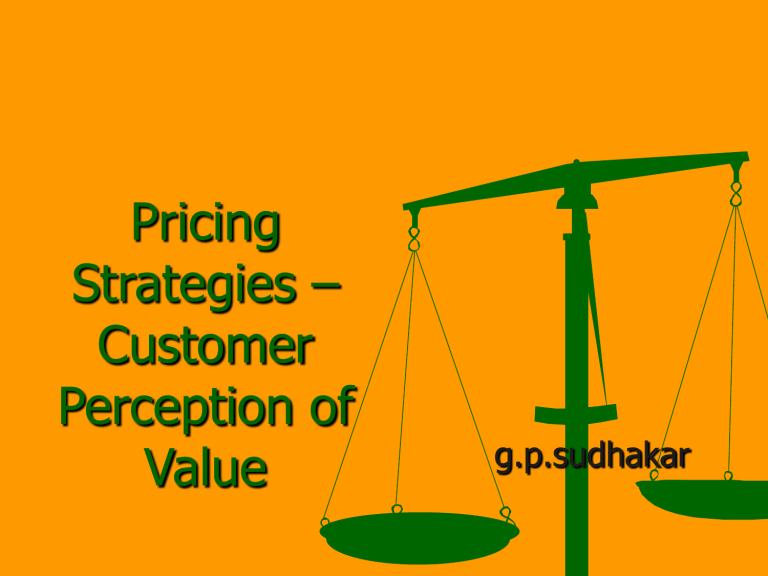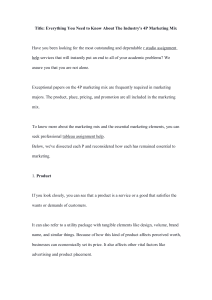
Pricing Strategies – Customer Perception of Value g.p.sudhakar “Customers move to the lower cost provider when marketers stop giving them reasons not to” - Tom Peters Price: what the consumer must give up to purchase a product or service Conceptual Issues in Pricing cont. Four basic types of consumer costs Money Time Cognitive activity Behavior effect Consumer costs: money The amount of money that any consumer is willing to pay for anything is highly subjective It’s influenced by MUCH more than just their income Time Necessary to learn about a product or service Required to travel to purchase a product or service Spent in a store Should not be treated only as the cost of purchasing Consumer costs: cognitive activity Thinking, learning, judging, evaluating the product Comparing purchase alternatives Researching the product Can be stressful, also easiest to avoid Consumer cost: behavior effort Purchasing involves behavior effort Consumers are willing to take on some marketing costs to reduce the rupee amount they spend – for example, they may take on part of the cost of distribution. (Did you buy your textbook online?) Consumers are willing to make trade-offs among various types of costs What sensory or emotional experiences are connected with price? What about cognition? Little consensus on basic issues regarding how price influences consumer choice processes and behavior Price Perceptions and Attitudes How price information is comprehended by consumers and made meaningful to them internal reference price Changes in price Price as a product attribute Reassuringly expensive? Low involvement products vs. high involvement products? How many prices do you have memorized? Issues in Perceived Price Reference prices – used as a basis for comparison in judging another price Internal External How do customers assess “Value”? (What is a reasonable price for this product) Customers develop “Reference Prices” Most recent price paid for this product Prices of competing brands Prices of substitute goods Price Environment Price is perhaps the most intangible element of the marketing mix External reference price How price information is communicated Conceptual Issues in Pricing General Model of Marketing Exchanges cont. Consumer costs Money Time Cognitive activity Behavior effort + Value = Price willing to pay Business costs Production Promotion Distribution Marketing research + Profit = Price willing to sell Marketing exchange Consumer Perception of Price Key areas Price –Quality inferences Reference Prices Price Cues Price Low Price Good Value It is about information regarding quality High Price Quality Image Price/Quality Relationship The perception of price as an indicator of product quality (e.g., the higher the price, the higher the perceived quality of the product.) Communicate too many attributes and customer suspects the price/offer! Price affects positioning... Customers are Willing to pay for relevance Willing to pay for excitement Willing to pay for quality Willing to pay for simplifying life Willing to pay for forward movement But selective and defiant Customers are happy to pay better than normal prices for Brand names Convenience Experience In emergencies/ for urgent needs Fashion/trends/fads Pricing strategy is based on consumer-product relationships What feature or attribute does the product have that consumers are willing to pay for? What competitive advantage does it have, and is it worth paying a premium for? Price Indifference 13% for batteries 17% for mouth wash 2% for deposit certificate more features fruity flavor minty flavor basic features Price sensitivity Tom Nagle offers this list of factors associated with lower price sensitivity The product is more distinctive Buyers are less aware of substitutes Buyers cannot easily compare the quality of substitutes The expenditure is a smaller part of the buyer’s total income The expenditure is small compared to the total cost of the end product Part of the cost is borne by another party The product is used in conjunction with assets previously bought The product is assumed to have more quality, prestige, or exclusiveness Buyers cannot store the product Perceived Quality Perceived Quality of Products Intrinsic vs. Extrinsic Cues Perceived Quality of Services Price/Quality Relationship Perceived Risk The degree of uncertainty perceived by the consumer as to the consequences (outcome) of a specific purchase decision Types Functional Risk Physical Risk Financial Risk Psychological Risk Time Risk How Consumers Handle Risk Seek Information Stay Brand Loyal Select by Brand Image Rely on Store Image Buy the Most Expensive Model Seek Reassurance The psychological pricing theory based on one or more of the following hypotheses: Consumers ignore the least significant digits rather than do the proper rounding. Fractional prices suggest to consumers that goods are marked at the lowest possible price. Now that consumers are used to psychological prices, other prices look odd. When items are listed in a way that is segregated into price bands (such as an online real estate search), price ending is used to keep an item in a lower band, to be seen by more potential purchasers. Impact of rate based information on consumer choice More sensitive to price than quantity Nominal/real value – face value effect Framing –per day/per year The pleasure of bargaining The store's ambiance may also be used to signal whether or not bargaining is appropriate. For instance, a comfortable and air-conditioned store with posted prices may not allow bargaining, but a stall in a bazaar or marketplace may. However, the importance of ambiance may depend on the cultural commitment to bargaining. In Israel, prices on day-to-day items (clothing, toiletries) may be negotiable even in a Western style store manned by a clerk. In India, a sign posted with the phrase fixed price indicates that bargaining is not allowed, although quite often this is not the case What is Customer Value? VALUE Quality Price Value VALUE is a personal judgment The consumer must judge the value of the product purchased to be GREATER than or equal to the sum of the costs VERY IMPORTANT NOTE: Just because we’re “on a budget” doesn’t mean we automatically choose the cheapest item in every category we shop for. Customer value-delivery system Figure 11.1 Customer delivered value Defining customer value Customer value is based upon the perception of the consumer. Customer delivered value Total customer value is the difference between total customer value and total customer cost of a product or service. It can be referred to as the ‘customer profit’. represents the total value of the entire product, incorporating services, personnel, and image values that a buyer receives from a marketing offer. Total customer cost the total cost of the monetary, time, energy and psychic costs associated with a marketing offer, in which the customer invests by purchasing the product. Customer Value Defined Overall Value Satisfaction Overall Quality Product Quality Sub-attributes Sub-attributes Customer Service Relative Price Competitiveness Marketing Sales Order Fulfillment Consumers tend to experience two sources of value for a product. Acquisition utility refers to the utility of obtaining a product, while transaction utility refers to the difference between a subject's reference price and the featured price. Initiating and Responding to Price Changes Possible responses to higher costs or overhead without raising prices include: Shrinking the amount of product instead of raising the price Substituting less expensive materials or ingredients Reducing or removing product features Removing or reducing product services, such as installation or free delivery Using less expensive packaging material or larger package sizes Reducing the number of sizes and models offered Creating new economy brands Pricing Strategy Analyze consumer-product relationships Analyze the environmental situation Determine the role of price in marketing strategy Estimate relevant production and marketing costs Set pricing objectives Business Objective includes profit! Figure 16.1: Nine Price-Quality Strategies Price Discrimination First degree – know each customer Second degree – Schedule of declining prices Third degree – different prices for different groups Two Part Pricing Charge a per-unit price that equals a marginal cost, plus a fixed fee equal to the consumer surplus each consumer receives at this perunit price – GRS fantasy park? Block Pricing Commodity Bundling Peak load pricing Price matching Randomized pricing And ……Brand loyalty Promotional Pricing Loss-leader pricing Special-event pricing Cash rebates Low-interest financing Longer payment terms Warranties and service contracts Psychological discounting Two Common approaches in Retail Pricing Strategy Everyday low pricing Prestige pricing 1. PRICING STRATEGIES EVERY DAY LOW PRICING (EDLP) The retailer charges a constant, lower every day price with no temporary price discounts. Hi-Lo PRICING Hi-Lo retailer charges higher prices on an everyday basis but then runs frequent promotions in which prices are temporarily lowered below the EDLP level. 2. COMPARING EDLP AND HI-LO Unit price EDLP HI-LO 8 7 6 5 4 3 1 1 2 3 4 5 6 7 8 9 10 11 12 13 14 15 16 17 18 19 20 21 22 23 24 0 Week 2 3. PROS FOR APPLYING EDLP Restoring the price credibility of the retailer Lower operating costs - reduced service and assortment - reduced inventory and warehouse handling costs due to steady and more predictable demand - lower in-store labour costs - reduced advertising expenses Increasing sales of the retailer Creates a proper context for private labels 4. PROS FOR APPLYING HI-LO Price discrimination: - first-degree and second-degree price discrimination - between consumers with different price sensitivity and - between informed and uninformed consumers Attraction of price-sensitive switchers with promotions to build store traffic while store-loyal consumers buy merchandise both on deal and at higher everyday prices. Category expansion when consumption rate are more flexible. Agressive temporary price reduction help to sustain a low-price value image.





